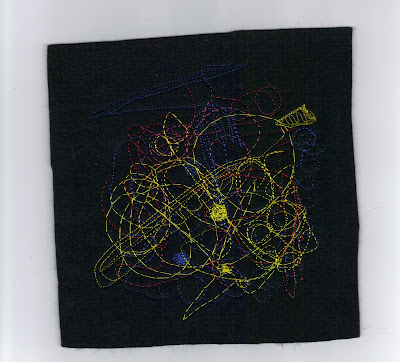Playing with Colours, Building Layers
Exercise 1 & 2 Page 74
 |
The top piece is stitching the three primary colours, red, blue and yellow using various widths and lengths of zig-zag stitch. I think each colour stands alone with no blending in. The dominant colours are red and yellow, possibly because the stitching is closer together with these colours. The blue is quite sparsely done. I don't feel the stitching is particulary exciting all though they are vivid, it does not do anything for me. I think the stitching is 'informative' and clear, bright but unimaginative.
The bottom piece has be stitched using the same primary colours as the first piece but with automatic patterns. This has added a little more movement to the stitching. I prefer the smaller stitches achieved by altering stitch width and length. This piece of stitching is a little bit more interesting though again, does not use my favourite colour scheme.
Embroidery with Secondary Colours Exercise 3 page 75 |
 |
This piece has been stitched on Razzle Dazzle fabric using primary and secondary colours with automatic patterns and changing widths and lengths of stitch. The chosen fabric helps to add more vibrancy as well as the use of secondary colours. It is more interesting, textural and vibrant.
Building Layers with Primary and Complimentary Colours Exercise 4 page 76
The first piece is using primary colour yellow with it's complimentary colour purple. I like the colour combination very much as it seems subtle and blends together in a pleasing way. I also like the automatic patter I have chosen. Again, I have used different widths and lengths of the same stitch.
The middle piece has been stitched using red and it's complimentary colour green. This is a very bright piece and contrasts with the first as it is not very subtle. It looks very Christmassy. I have not used varying widths or lengths of stitch.
The third piece has used blue with it's complimentary colour orange. The colours blend in a more subtle but stronger way than the first piece. I used altering lengths and widths of the same stitch.
I have loved stitching these and enabled me to see the possibilities that stitch on stitch and colour on colour can create.
More Experimenting Exercise 5 - page 76
This was great to do. It was good to think of an idea and follow it through. The middle section is a mixture of red, orange and yellow and the side pieces are purple,blue and green. The I like the way the design and the colour have added movement to it all.
Colour Grading Exercise 6 - page 77
|
This was horrible, and a let down after getting on with the last piece. It felt like taking a step back. Arrgghh.
Monet Colour
Exercise 7 - page 78
This is Monet's House of Parliament, painted in 1904 and I have chosen to depict the vivid central piece in the picture. The colours I can pick out are pale blue, mid blue, yellow, amber, burnt orange, bright orange, gold, dark pink, mid pink, red, violet and indigo.
This is my attempt at capturing the colours
Exercise 8 - page 79
This is stitched on black felt with a black felt stabiliser. I like the automatic pattern I have chosen as it helps to blend the colours together. I chose not to use free embroidery. The black felt adds to the dramatic effect of the colours. I started with layers of blue and green, then yellow, oranges, pinks, violets and indigo. Sometimes I used two threads in the same needle. I started trying to be systematic in layering the colours but ended up just going with what felt right rather than looking at the picture. Looking at it now I can see it needs more orangey yellow in the centre.
This has been stitched on Razzle Dazzle fabric and using the same colours and stitch selection as the piece on black felt. I prefer the piece on black felt as it helps provide the atmosphere created in Monet's painting by bringing the colours alive.
Finally I have tried to use primary colour and secondary colours, using 2 threads in the same needle and a little bit of black with some of the red to create a different purple. Unfortunately I used a straight pink absentmindedly.
This has been a great chapter which I have really enjoyed and got a lot from.





















































